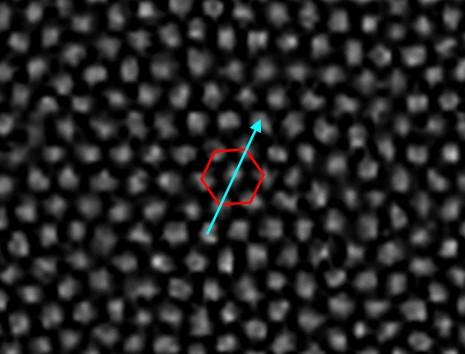Cooperation within the TopDyn research center paves the way for the investigation of two-dimensional phases and phase transitions

Credit: ill./©: Jakub Zázvorka, Florian Dittrich
In a collaboration between experimental physicists and theoretical physicists in the framework of the Dynamics and Topology (TopDyn) excellence project, a system of many small magnetic whirls could be engineered to form a regularly ordered state. Such a transition from a disordered to an ordered phase is analogous to the well-known crystallization, which, however, occurs here in two dimensions. For the research work at Johannes Gutenberg University Mainz (JGU), experimental physicists around Professor Mathias Kläui cooperated with a group of theoretical physicists around Dr. Peter Virnau. The results have been published recently in the journal Advanced Functional Materials. The TopDyn research center is funded by the German federal state of Rhineland-Palatinate.
Two-dimensional systems are a topical area of research in theoretical and experimental physics. These systems can attain a number of exotic states and exhibit transitions that do not exist in three dimensions. One such example is the Kosterlitz-Thouless transition, for which the Nobel Prize in Physics was awarded in 2016. Another example is the so-called hexatic phase, which occurs in systems of two-dimensional hard discs in between the disordered liquid and strongly ordered solid phase.
Two-dimensional model system generated from skyrmions
In the work now presented, magnetic whirls, so called skyrmions, were realized in ultra-thin metal multilayer films. The number of skyrmions and their size could be tuned by applied magnetic fields. These are ideal conditions for the experimental realization of dense two-dimensional model systems. In particular, the researchers were able to generate an experimental system that exhibits the signature of an emerging hexatic phase. This demonstrates that the system indeed behaves like a two-dimensional system and can be described by hard discs. Furthermore, the results allowed for the determination of the repulsive interaction between skyrmions, which could be modelled by computer simulations.
“I am very glad that the joint work between the Soft Matter Theory group of Dr. Peter Virnau and our experimental group led to this exciting work. Such new collaborations are exactly the aim of the TopDyn research center,” said Professor Mathias Kläui, TopDyn spokesman.
Since the properties of skyrmions can be tuned by external magnetic fields, this is an important first step towards the tailored preparation and analysis of the dynamics of two-dimensional phases and phase transitions. Perspectives of further possibilities of effects to be studied in such systems can be found in a recently published News & Views Article in Nature Nanotechnology.
The Dynamics and Topology research center was founded in 2019 as a collaborative center of Johannes Gutenberg University Mainz, TU Kaiserslautern, and the Max Planck Institute for Polymer Research in Mainz. It is funded by the state of Rhineland-Palatinate and pursues a highly interdisciplinary approach.
###
Media Contact
PD Dr. Peter Virnau
[email protected]
Original Source
https:/
Related Journal Article
http://dx.




